UK: Chinese Oak Silkmoth; Oak Tasar Silkmoth; Oak Tussah Silkmoth, F: Ver à soie Tussah, D: Chinesischer Eichenseidenspinner, RUS: Pavlinoglazka kitayskaya dubovaya, PL: Jedwabnik chinski, FIN: Kiinantammisilkkikehrääjä, DK: Kinesisk egespinder, CH: Jitou mutian cán'é.
Bombyx pernyi Guérin-Méneville, 1855, Revue Mag. Zool. (2)7: 296.(Taxonomic note. There is some evidence to suggest that Antheraea pernyi is a feral animal of sericultural origin that has 'escaped' into the wild from domestication. The wild progenitor appears to be Antheraea roylei Moore, 1858 from tropical and subtropical central and southern China, from which it evolved by chromosome rearrangement. 'Hybrid' crosses in India between the two (with the scientific name Antheraea proylei Jolly, 1973) were found to be fully fertile through numerous generations (Liu, Li, Li & Qin, 2010; Peigler, 2012).)
Type locality: Northern China.
Holarctic; eastern Palaearctic region. Pleistocene refuge: Monocentric -- Manchurian refuge. Introduced elsewhere.
Wingspan 110--152mm. The similarly marked and coloured sexes are unlike any other european saturniid except the introduced Antheraea yamamai, but it can easily be distinguished from that species in having the solid elongated black spot on the outer margin of the hindwing eyespot invaded by yellow. In males, the forewings are distinctly falcate.
This species is not very variable in colour, unlike Antheraea yamamai, with individuals differing little from the typical fawn colour of the male illustrated below; however, a chocolate-brown melanic form is known -- f. hartii Moore.
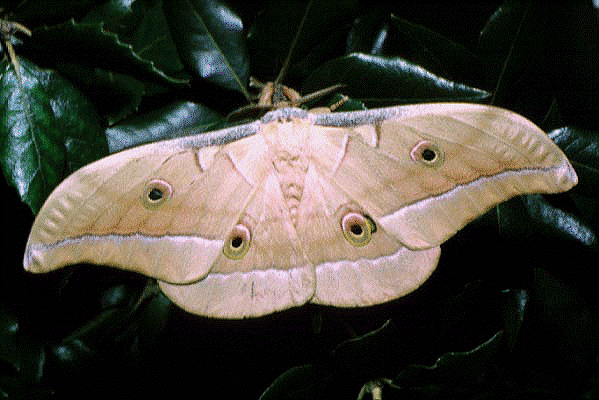
A nocturnal species which frequents open deciduous and evergreen forests dominated by oaks (Quercus).
Most adults emerge in the late morning, but few females call that same night. Pairing usually takes place just before midnight on the second night and lasts for about 24 hours. The female then clambers around laying eggs in clusters on the nearest leaves. The reason for this odd behaviour is that most females carry too many eggs at first and are 'bottom-heavy'. This stop-start process continues until about 30 eggs have been deposited. The rest of the eggs are laid on the wing over a larger area. Both sexes of this species are readily attracted to light and can be found by day 'resting' on posts and walls below these.
Mainly May and August as two generations in the cooler north of its range. Oddly, in the warmer south it has only one generation (Peigler, 2012).
OVUM: Round to slightly oval, dorso-ventrally flattened, 2.6 x 2.5mm, china-white with brown gum. Laid in clusters of up to five on the leaves of the host, hatching 10--14 days later.
LARVA: Full-fed 80--90mm. Polychromatic. The newly-hatched, 5mm long larvae are basically dull black with a glossy, dull orange head. The tubercles are also black, with several white setae. From the second instar the larvae are very similar to those of Antheraea yamamai, except for a raw sienna to fawn coloured head, which bears five dark spots on each lobe of the face. Although larvae are normally green, some 'domesticated' strains are yellow, blue, or even orange.
Newly emerged larvae take some days to settle down under a leaf. From the third instar onwards many larvae exhibit a kind of 'wanderlust', feeding at one spot for about four days before wandering off along the branches to a new location. This may be a survival strategy, for in it's latter stages great quantities of foliage are consumed -- the stout and compact larvae rely on cryptic coloration for concealment as they hang among a leaf cluster.
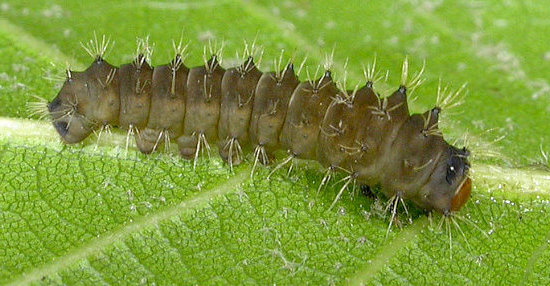
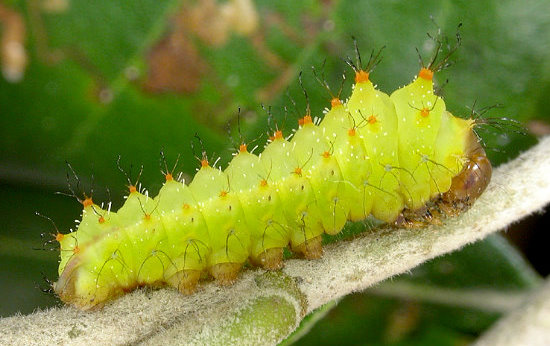
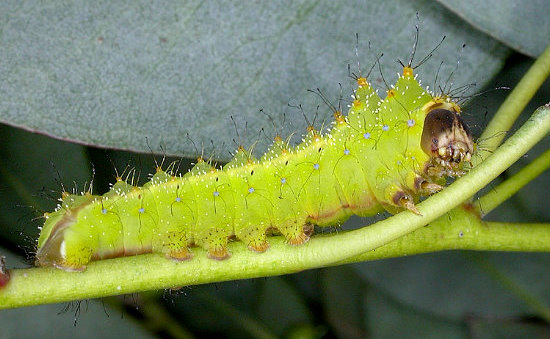
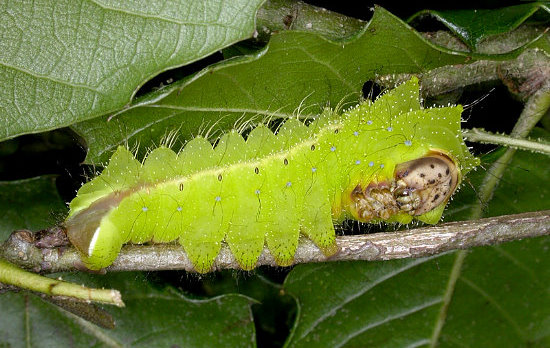
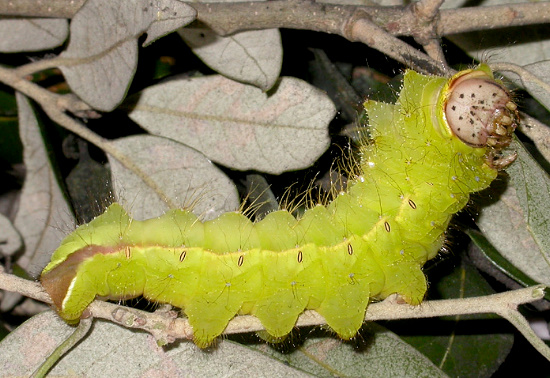
Hostplants. Oaks (Quercus spp.) are preferred; however, it can also be found on beech (Fagus sylvatica), sweet chestnut (Castanea sativa), birches (Betula), hawthorns (Crataegus), hornbeams (Carpinus), Prunus and several other trees and shrubs.
PUPA: 35--45mm. Cylindrical, but tapering towards both ends -- mahogany-brown. Formed in a tight, hard, egg-shaped, single, sealed, buff, 50 x 25mm cocoon with a loose greyish outer wrap -- the source of Tussore/Tussah silk. This is spun up in a cluster of leaves and twigs, and is fixed to the nearest twig by a silk peduncle. The adult breaks out of this by softening and partially dissolving one end. Unlike in Antheraea yamamai, this is the overwintering stage.
Eupelmidae: Eupelmus sp.
An introduced species (late nineteenth century) whose natural home is the eastern Palaearctic region. It can now be found in Europe in northeastern Spain near Barcelona (Leraut, 2006), and on the Balearic Islands of Mallorca (Pinya, Suárez-Fernández & Canyelles, 2013; Maria Cantallops, iNaturalist 2022) and Menorca (Kay Gardiner, iNaturalist 2024; Kathryn, iNaturalist 2020). On top of this, amateur breeders often release this species so that individuals can turn up amost anywhere.
Extra-limital range. Eastern and central China, Taiwan, Korea, and, maybe, the southern Russian Far East. Introduced into Japan (Honshu and Kyushu). However, all Russian, Japanese and Korean records appear to be feral populations or escapees.
Records of Antheraea pernyi from the Russian Far East (Izerskiy, 1999a) and Mongolia are dubious (Peigler, 2012). It has been used for sericulture in Russia since at least 1924 (Nikitin, 1936). Izersky (1999a) gave collection data for four specimens of Antheraea pernyi from Russia’s Far East, but added that it overwinters in the egg stage, proving that he misidentified specimens of Antheraea yamamai (Guérin-Méneville).
It should be noted that this species has been reared for Tussah 'wild' silk on oak trees in China for more than two millennia, primarily in the northeast provinces of Shandong, Liaoning, and Hebei. It was introduced into Japan for sericulture in 1877, where it was cultivated on a small scale into the 20th century. It is also raised in both North- and South Korea. Interestingly, Antheraea pernyi is rarely collected wild in either of the Koreas. In a detailed treatise on South Korean moths, Park & Tshistjakov (1999) cited only three captures of Antheraea pernyi, the rarity of which suggests that these were escapees from sericultural colonies. These were from Seoul in 1938, Cheju-do in 1924, and Geoje-do in 1992, the latter two being islands. No wild material of Antheraea pernyi from North Korea was found in the extensive East European and South Korean collections of moths from North Korea (Park et al., 2001), although cultures of the tussah silkmoth have been maintained there (Peigler, 2012).
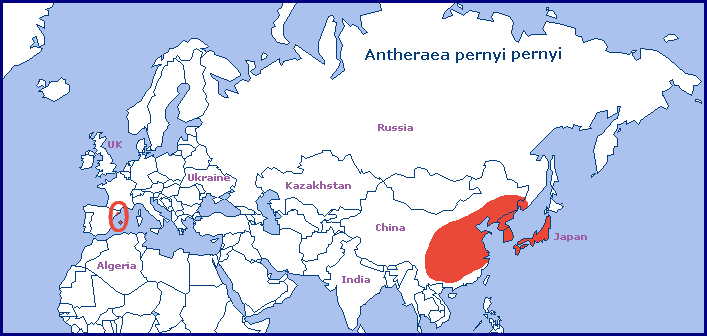
Two, namely korintjiana Bouvier and roylei Moore, which occur in northern India and South East Asia. (See Taxonomic note above with regard to roylei.)
 Return to species list
Return to species list